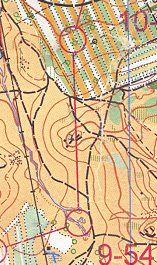[13-Jun-04]

This was the second to the last leg in the APOC relay. It was visible from
the spectator area, and many people seemed to take the around to the left
route (some people staying a line high in the rough open).
I went straightish thru the saddle, and was happy with it. My thought was
that the control was trivialized by this route, whereas the left route
had the potential to be a bit tricky. The assembly area was on the other
side of these bands of vegetation, and we could observe before the race that
the forest was thickish, possibly tough to get thru cleanly, and offered poor
visibility. I was running as fast as possible and did not want to screw up
this late in the race.
People questioned my choice and we compared splits. My split was faster than
the people I compared with, but they said they lost time because the bobbled
the control coming in from the left.
There is no real moral to this story. I just thought it was an interesting
leg. Once I saw the trivial route, my brain turned off, even if it meant
climbing those extra lines. If my game plan was to be as aggressive as
possible in this race, perhaps I should have considered the left route. But
I'm not convinced it is much faster even if the control is spiked that way.
I am convinced that the potential gain does not merit the probability of a
boom and the possibility of the time lost reaching close to a minute if
you get confused in there. I am convinced that O is an economics
game, and the brain gets naturally tuned to economic problems, and that
that is part of route choice, but I still struggle with ways to train it.
(There is a body of cognitive psychology thought that hypothesizes that
economic decision making skill is to some extent hardwired in the brain
(as opposed to learned), just like physical prowess is largely determined
by genetics -- thoughts to explore another day).
In an absolute sense, given runners of equal physical skills, can we ever
know what the best route is before running them?